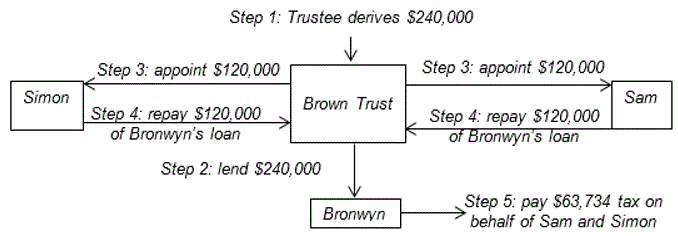Non-residents* no longer have entitlement to the 50% capital gains tax discount (the Discount) on their Australian capital gains, save grandfathering, but the inverse isn’t true: Residents* can apply the Discount to foreign capital gains that meet the requirements of the Discount in their Australian tax.
The CGT discount
Obtaining the Discount principally requires:
- the entity who made the gain being an individual either directly or as the beneficiary of a trust [50% discount] or a superannuation fund [33⅓% discount] : section 115-100 of the Income Tax Assessment Act [ITAA] 1997). That is the entity is not a company. Companies are ineligible for the Discount;
- the CGT asset on which the gain is made was held for at least twelve months: section 115-25; and
- the gain made is not otherwise treated income under the ITAA 1997. So where a gain is both assessable income and a capital gain under the ITAA 1997 the gain is not taxed as a capital gain and so the Discount cannot apply too: section 118-20.
How taxation of foreign income works
Broadly foreign capital gains are included in the Australian assessable income of a resident just as domestic capital gains are. Resident taxpayers are taxed on income from all worldwide sources: sections 6-5 and 6-10. Notable exceptions are foreign income of companies from:
- their foreign branches with an permanent establishment in those foreign places: section 23AH of the ITAA 1936; and
- foreign subsidiaries of Australian resident companies or where a company has non-portfolio (at least 10%) holding in a foreign company: section 768-5 of the ITAA 1997.
Foreign income, including of capital gains, of a resident is separately taxed (or exempted) under Australian tax rules even where the foreign income has been, or is to be, taxed under a foreign regime. To address the prospect of double (foreign and domestic) taxation of foreign income a foreign income tax offset (FITO) is available: Division 770 of the ITAA 1997. Australian tax on foreign income can be offset by a FITO for the foreign tax a resident taxpayer has paid, as a non-resident typically but dual tax residence is possible, in the foreign place the foreign income came from.
Double tax and double tax treaties
Australia has double (bilateral) tax treaties with many countries including all large countries and major trading partners which:
- mutually allow source taxation of income of non-residents of each country (jurisdiction) at tax rates lower than both non-treaty rates and domestic rates on some forms of foreign income – this reduces foreign tax and, consequently the FITO needed to offset that foreign tax; and
- provide a structure to alter domestic tax law, if need be, to prevent situations where taxpayers will be taxed in both places (double tax) on the same income.
The tax treaties reserve rights to a treaty partner to tax real estate where a taxpayer is resident in the other jurisdiction and taxation of capital gains made on the realisation of real estate, unlike typically interest, dividends and royalties, is not capped at lower rates in the treaties. Broadly this means Australian residents, as non-resident taxpayers, pay foreign capital gains taxes at rates comparable to, or even higher than, the taxes locals pay on capital gains made on foreign real estate.
It follows that foreign capital gains tax can be significant. Can this foreign tax payment be used as a FITO to offset the CGT on an Australian Discount capital gain? The FITO available to offset Discount capital gains on real estate and other investments was considered by the Full Federal Court in Burton v Commissioner of Taxation [2019] FCAFC 141.
Burton v Commissioner of Taxation
In Burton v Commissioner of Taxation it was found that 50% only of US tax paid on a capital gain made on US investments by an Australian resident individual taxpayer was offsettable against the individual’s Australian tax as a FITO.
The reason for this finding is technical but can be understood as follows:
In essence a FITO under section 770-10 of the ITAA 1997 is strictly confined to foreign income that is subject to foreign tax. Under the Discount regime in Division 115 and under section 102-5 of the ITAA 1997 only the net capital gain after applying the Discount, which is 50% in the case of a resident individual, is included in assessable income. It follows that a component of a capital gain taxed as a foreign capital gain is not taxed in Australia where the capital gain is a discount capital gain under Division 115. That is a Discount capital gain to an Australian resident individual taxable on their worldwide income that arises from a capital gain made in the US is made up of:
- 50% that is taxed in the US which is included in Australia assessable income as net capital gain; and
- 50% that is taxed in the US but which is not included in assessable income in Australia viz. it is exempt from tax in Australia.
The Full Federal Court confirmed that a FITO is only available in relation to the first of these 50% categories. Logan J. stated at paragraphs 84 and 86:
84. Read in context, the text of s 770-10 is, in my view, fatal to the success of the alternative foundation of Mr Burton’s appeal, grounds 1 to 4 of which challenge the correctness of the conclusion adverse to him reached by the learned primary judge in relation to the allowance of foreign tax offsets under s 770-10 of the 1997 Act. An amount of foreign tax paid only counts towards a tax offset if it was paid “in respect of an amount that is all or part of an amount included in your assessable income for the year”.
….
86. Section 770-10 looks to “an amount that is all or part of an amount included in your assessable income for the year”. The term “assessable income” is defined in s 995-1 of the 1997 Act, which is not the same as “income” as understood for the purposes of the Convention. As defined in the 1997 Act, assessable income includes “ordinary income” (s 6-5) and, materially, what is termed “statutory income” (s 6-10). One form of statutory income included in assessable income is a net capital gain included pursuant to s 102-5(1) of the 1997 Act. As a matter of ordinary language flowing from the text of s 770-10 and, in turn, s 102-5(1), it is only the net capital gain which is, in each instance, included in Mr Burton’s assessable income. Regard to ss 6-5, 6-10 and 102-5 highlights that the phraseology “included in your assessable income” is pervasive in the 1997 Act. There is no contextual warrant for construing “included in” as extending to an amount which is used for computation of an amount that is included in assessable income. The learned primary judge (at [113] – [114]) reached just such a conclusion. That conclusion was correct, for the reasons given by his Honour.
Burton v Commissioner of Taxation [2019] FCAFC 141 at paras. 84 and 86
Repercussions
This outcome is quirky and is entirely due to the laboured statutory drafting of the CGT provisions which is in part consequence of laudable efforts to rewrite and improve the Australian legislation with the advent of the ITAA 1997. If, instead, the taxation of discount capital gains had been governed by a rate set in less intelligible and obscure fine print in the Income Tax Rates Act 1986 as say 50% of the rate otherwise applicable, with that net rate to apply to the whole capital gain; then the whole of the US tax paid on the capital gain could have been offsettable as a FITO. In other words a half of the FITO would not have been lost to Mr. Burton due to the clash of legislative style with treaty terms.
But that is not the case. Accordingly Australian residents with Discount capital gains which are foreign capital gains need to ensure FITO claims in their Australian income tax return reduce the foreign tax claimed by the discount percentage to ensure no FITOs are claimed for the non-assessable/exempt component of the foreign capital gain that technically arises under the Australian CGT legislation.
*In this post resident and non-resident respectively mean resident and non-resident for tax purposes: see “resident of Australia” defined in sub-section 6(1) of the ITAA 1936.











